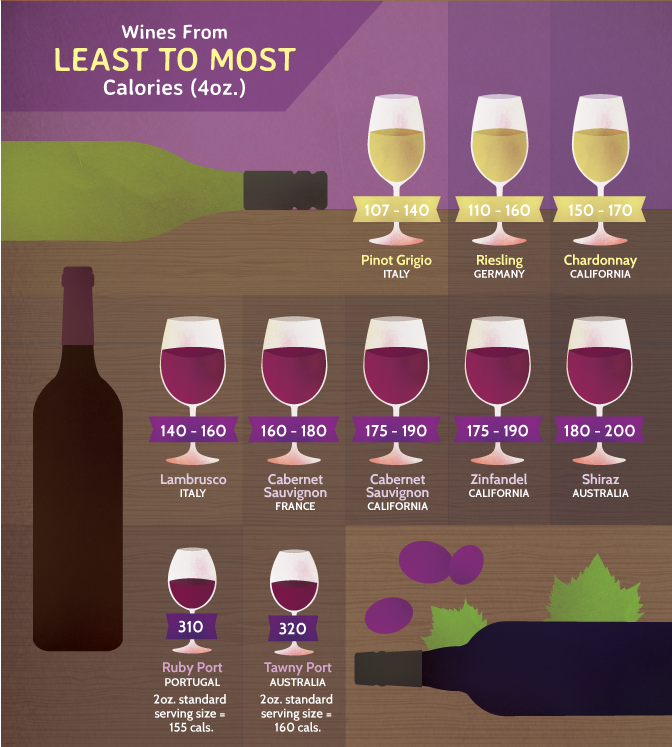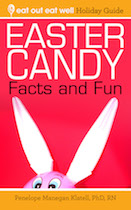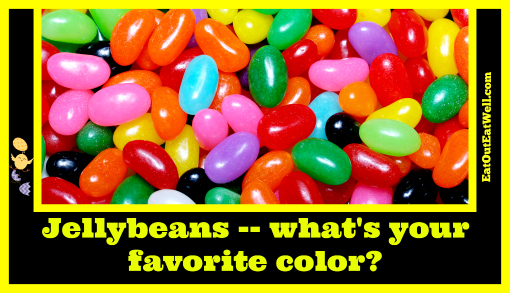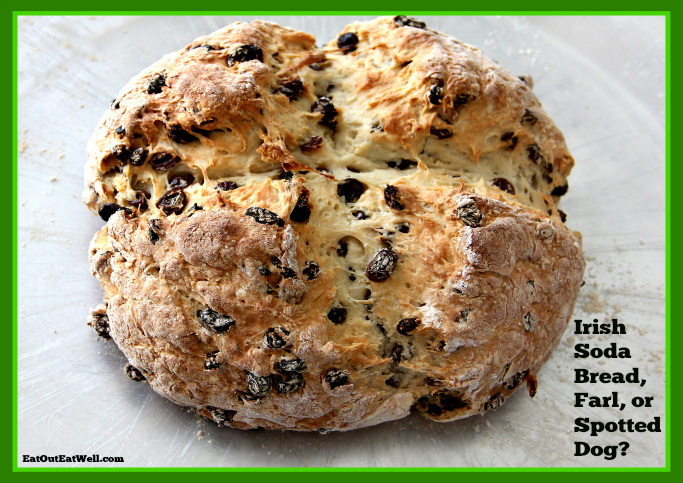
Source: Fix.com
Food for Fun and Thought
How Far Do You Have To Walk To Burn Off Your Easter Candy?
 If you want to attempt to walk off the chocolate bunnies, jellybeans, and Peeps:
If you want to attempt to walk off the chocolate bunnies, jellybeans, and Peeps:
It takes a herculean effort to walk off lots of calories. It’s easier and more efficient to cut down on portion size. In case you want to make an attempt “to walk” off your candy indulgence:
If this is the candy in your Easter basket — and you eat it all:
- 25 small jellybeans
- 5 Peeps
- 8 malted milk robins eggs
- 1 ounce chocolate bunny
- 1 Cadbury Creme Egg
- 4 Lindt Chocolate Carrots
that adds up to 990 calories. You will need to walk 9.9 miles, 15.96 kilometers, or 19,800 steps, assuming you cover one mile in 2,000 steps.
If this is in your basket:
- 25 small jellybeans
- 5 Peeps
- 5 marshmallow chicks
- 8 malted milk robins eggs
- 1 large 7 ounce chocolate bunny
- 1 chocolate-covered marshmallow bunny
- 1 Cadbury Creme Egg
- 1 Cadbury Caramel Egg
that comes to 2076 calories. You will need to walk 20.76 miles, 33.48 kilometers, or 41,520 steps, assuming you cover one mile in 2,000 steps.
If you’re going “light” and only eat:
- 25 small jelly beans
- 5 Peeps
- 1 medium (1 3/4 ounce) hollow chocolate bunny
- 1 Cadbury Creme Egg
you would rack up 730 calories and you will need to walk 7.3 miles, 11.77 kilometers, or 14,600 steps — assuming you cover one mile in 2,000 steps — to walk off that number of calories. Sounds like a lot, but it is very doable over a few days.
Holidays and Celebrations
Holidays are days of celebration. But remember that a holiday is just one day and our bodies can easily compensate for a day of indulgence. Problems start when the holiday eating keeps going and going — which is easy to do when there are cabinets stuffed with Easter candy and bowls full of it every where you turn.
So arm yourself with some information, enjoy your holiday, and don’t feel obliged to eat every piece of candy in sight – the first bites always taste the best!
Please share this post with someone who may have eaten every last chocolate egg and jellybean in the Easter basket!
Happy Easter
Jellybeans: Do You Eat Them By The Handful Or One-By-One?
Jellybeans: do you think they should they should come with a warning label, “STOP NOW or you’ll keep eating until they’re gone?”
Seriously – it’s pretty darn hard not to love those little nuggets of sweetness that come in multitudes of colors and flavors and get stuck in your teeth!
The Birth Of The Jellybean
The gummy insides of the jellybean might be related to the centuries old treat, Turkish Delight. And their outsides bring to mind the colored hard candy coating, developed in the late 17th century, for the Jordan almond.
The modern jellybean became popular during the American Civil War when Boston’s William Schraft encouraged sending candy to Union soldiers and the jellybean held up well.
Jellybeans were the first bulk candy. They were first sold by weight as penny candy in the early 1900s – bulk jellybeans for nine cents a pound.
Around 1930 they became popular as Easter candy because of their egg shape, which represents spring, fertility, and resurrection.
The Many Flavors And Colors Of Jellybeans
Standard jellybeans come in fruit flavors but there are a huge number of flavors available — some goofy, some sophisticated — like spiced, mint, gourmet, tropical, popcorn, bubble gum, pepper, and cola. They also come in a sugar free version (seems weird, but true).
Whatever your flavor preference, Americans eat a whole lot of jellybeans – around 16 billion at Easter — enough to circle the globe nearly three times if all the Easter jellybeans were lined up end to end.
Handfuls Or One By One — And What Flavor?
How do you eat your jellybeans? Do you go for handfuls at a time or pick and choose your colors and eat them one by one?
- 70% of kids ages 6–11 prefer to eat Easter jellybeans one at a time
- 23% say they eat several at once
- Boys (29%) are more likely to eat a handful than girls (18%)
- Kids say their favorite Easter jellybean flavors are cherry (20%), strawberry (12%), grape (10%), lime (7%), and blueberry (6%).
What’s In The Hard Shelled Nugget Of Sweetness?
Jellybeans are primarily made of sugar and also usually contain gelatin (Jelly Bellies don’t), corn syrup, modified food starch, and less than 0.5% of citric acid, sodium citrate, artificial flavors, confectioners glaze, pectin, carnauba wax, white mineral oil, magnesium hydroxide, and artificial colors (takes some of the fun out of them, doesn’t it?).
Originally, there was just the traditional jellybean, which has flavor only in the shell. In 1976, the Jelly Belly (Goelitz) Candy Company introduced gourmet jellybeans. Unlike traditional jellybeans, Jelly Bellies are smaller and softer than the traditional kind and are flavored both inside and outside. Jelly Belly makes about 50 different flavors of gourmet jellybeans.
How Many Calories Are In Jellybeans?
Even though they may give you Technicolor insides, jellybeans are fat free. On average:
- 10 small jellybeans (11g) have 41 calories, no fat, no cholesterol, no protein, and 10.3 grams of carbs
- 10 large jellybeans (1oz or 28g) have 105 calories, no fat, no cholesterol, no protein, and 26.2g carbs
- 10 Jelly Bellies have 40 calories (4 calories a piece), or about 100 calories in a single serving (25 beans)
Some Jelly Belly Jellybean Trivia
- Jelly Bellies were invented in 1976. They were the first jellybeans to be sold in single flavors and to come with a menu of flavor choices.
- It takes 7 to 21 days to make a single Jelly Belly jellybean.
- Very Cherry was the most popular Jelly Belly flavor for two decades until 1998, when Buttered Popcorn took over. Very Cherry moved back into the top spot by only 8 million beans in 2003.
- Some jellybeans do contain gelatin, but Jelly Bellies don’t. According to the Jelly Belly website, they are suitable for vegetarians although strict vegans may have issues with the beeswax and shellac that are used to give them their final buff and polish.
- Jelly Belly doesn’t use wheat, rye, barley, or oats in the basic recipe for Jelly Belly jellybeans but does use cornstarch as the modified food starch.
- Jelly Bellies have been certified kosher for the last two decades by the Kashrut supervision of KO Kosher Service. Since 2007 all Jelly Belly products have been certified by the Orthodox Union. Teenee Beanee jelly beans and Just Born jellybeans are Pareve & O/U; Jelly Bellies are certified OU Kosher.
For 99 cents you can get the lowdown on Easter Candy. Check out my ebook Easter Candy Facts and Fun on Amazon. You’ll spend less than you would on jelly beans. It’s also way fewer calories than a chocolate bunny!
Irish Soda Bread Or Green Bagels?
It’s not too hard to find green bagels, beer, or green milkshakes on St. Patrick’s Day in the US. There’s also corned beef and cabbage – and “Irish soda bread” with a cruciform, or cross, slashed on top. Have you ever wondered why the shape of the cross is slashed on the top of the bread – and why it’s known as soda bread?
Soda Bread and Native Americans
The earliest reference to the chemical reaction that makes soda bread rise is actually credited to American Indians. Centuries before soda bread became popular in Ireland, they added pearl-ash (potash), the natural soda in wood ashes, along with an acidic ingredient, to make the breads rise.
Soda bread became popular in Ireland when bicarbonate of soda, also known as bread soda, became available to use as a leavening agent. Bread soda made it possible to work with the “soft” wheat grown in Ireland’s climate. “Hard” wheat flour, the main kind used in the US today, needs yeast to rise properly. “Soft” wheat flour doesn’t work well with yeast but is great for “quick breads” like soda bread.
According to The Society for the Preservation of Irish Soda Bread the earliest published recipe or soda bread was in a London magazine in 1836 – also later repeated in several US papers – that refers to a “receipt for making soda bread” found in a newspaper in Northern Ireland. The praise: “there is no bread to be had equal to it for invigorating the body, promoting digestion, strengthening the stomach, and improving the state of the bowels.” Sounds like tasting good wasn’t a big priority!
In 19th century Ireland, making bread was part of daily life and most families lived in farmhouses where kitchens had open hearths, not ovens. Bread soda meant that anyone who didn’t have an oven (most people in Ireland in the 1800’s didn’t) could make soda bread.
The bread soda wasn’t perishable, was relatively inexpensive and buttermilk, a by-product of making butter, and the soft wheat for flour, both necessary components of soda bread, were commonly available. The bread was cooked on a griddle or in a bastible, a big cast-iron pot with a lid that could be put right into coals or a turf fire.
Brown or White; Cake or Farl?
“Plain” soda bread often appears with a main meal — to soak up gravy – or at breakfast. It comes both brown and white, and in two main types, cake and farl.
Traditional brown Irish soda bread is basic table bread made from whole meal flour, baking soda (bread soda), salt, and buttermilk. White soda bread, made with white flour, is considered slightly more refined than brown soda bead and is sometimes considered a more special occasion bread.
Cake tends to be found more in the south of Ireland while people in Northern Ireland seem to prefer farl — although both can be found in the North and South, sometimes with different names.
Cake is soda bread that is kneaded, shaped into a flattish round, then deeply cut with a cross on the top. Now it’s normally baked in an oven.
For farl the dough is rolled into a rough circle and cut all the way through — like a cross — into four pieces or farls (“farl” is a generic term for a triangular piece of baking). It’s usually baked in a heavy frying pan, on a griddle, or on top of the range or stove. It’s flatter and moister than cake. Each farl is split in half “the wide way” before it’s eaten and is best when hot. It’s also allowed to cool and then grilled or fried as part of other dishes — especially the Ulster Fry, a local breakfast where golden and crispy soda bread and potato farls have ben fried in reserved bacon fat and then served with Irish bacon, sausage, black pudding, tomato and egg.
What’s Spotted Dog?
There are regional variations of the basic soda bread recipe – even though some purists would say there should be no additions to the dough.
In Donegal caraway seeds were traditionally put in the bread. In earlier and leaner times when raisins or dried fruit were luxuries, a fistful of them or maybe even a little sugar or an egg — if either could be spared — would have been put into the white flour version of the bread during the harvest as a treat for the working men.
The non-traditional varieties of soda breads that are made with raisins, caraway, orange zest, and other add-ins are often called Spotted Dog.
What About The Cross On Top?
Before baking, a cross is traditionally cut on the top of the soda bread loaf with a knife – often said to ward off the devil and to protect the household.
Legend and symbolism aside, there’s a practical reason for the cruciform shape to be cut into the top of the dough. Slashing the dough lets heat penetrate into the thickest part of the bread and allows the bread to stretch and expand as it rises.
Slashing a round loaf with a cruciform shape ends up dividing the bread into quadrants that can be easily broken apart (the breaking of the bread). But, since Ireland is a Catholic country, the symbolism of the cross can also be interpreted as blessing (crossing) the bread and giving thanks.
One serving (74 g) of Irish Soda Bread with raisins and caraway seeds has 214 calories, 3.67g fat, 41.51g carbs, 4.86g protein.
 For 99 cents you can have the lowdown on Easter Candy. Get my book Easter Candy Facts and Fun from Amazon. You’ll spend less than you would on jelly beans. It’s also not as many calories as a chocolate bunny!
For 99 cents you can have the lowdown on Easter Candy. Get my book Easter Candy Facts and Fun from Amazon. You’ll spend less than you would on jelly beans. It’s also not as many calories as a chocolate bunny!
Some Great Popcorn Ideas For Academy Award Watching
When you think movie, do you also think popcorn? A good percentage of movie viewing people do.
And what’s the biggest movie night of the year? The Academy Awards, of course.
Oscar has been around for a long time – the first Academy Awards ceremony was in 1929 – but the main snack food that’s associated with movies has been around a lot longer.
The Evolution of Popcorn
The puffy goodness we know as popcorn is a strain of corn (from maize) cultivated in Central America about 8,000 years ago. North American whalers probably brought popcorn to New England from Chile in the early 19th century. Popping popcorn was fun and its appeal spread across the country.
By the mid 1800’s popcorn was widely available, especially at places like circuses and fairs. The invention of the steam-powered popcorn maker in 1885 meant popcorn could be made anywhere. Amazingly, the only place where it wasn’t available was in theaters, which typically had carpeted floors. Theater owners didn’t want popcorn “dirtying” up the place.
Popcorn and Movies
Because of its popularity, theater owners began to allow popcorn vendors to sell popcorn outside their theaters. During the Great Depression people looked for cheap diversions and movies were it. Popcorn — at 5 to 10 cents a bag — was an affordable luxury.
Theater owners began to lease their lobbies to popcorn vendors, but figured out they could make more money by selling it themselves. Selling popcorn, candy, and soda from their own concession stands meant higher profits. Sugar shortages during World War II made sweet treats hard to come by, and popcorn became the main snack. By 1945 over half of the popcorn eaten in the US was consumed in movie theaters.
It’s still king. Americans eat, on average, about 13 gallons of popcorn a year. It’s cheap to make and allows for a huge price mark-up. You might pay $5 for a bag of popcorn, but it costs the theater about 50 cents. Plain popcorn doesn’t have all that much flavor, so yellow oil (it isn’t butter) and salt are added to make it tasty and make you thirsty. So, you buy a soda. No wonder movie theaters make an estimated 85 percent profit from concession sales.
Popcorn Recipes
This Sunday as you prop your feet up to watch the glamorous stars grab their golden statues, make sure you have a good supply of popcorn on hand. You don’t have to settle for the plain variety – unless you want to. There are some fantastic popcorn recipes with names like Bacon Bourbon Caramel, Cinnamon Candy (red, like the red carpet), Peanut Butter Popcorn, and Endless Caramel Corn.
For even more popcorn recipes to accompany your cheers, boos, oohs, and ahs on Oscar night, check out:
Food Network’s 50 Flavored Popcorn Recipes


